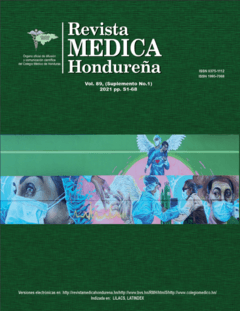Hemorragia gastrointestinal oculta, un diagnóstico retórico
DOI:
https://doi.org/10.5377/rmh.v89iSupl.1.11891Palabras clave:
Hemorragia gastrointestinal, Intestino delgado, Protocolos clínicosResumen
Antecedentes: La hemorragia gastrointestinal oculta representa aproximadamente del 5%-10% del total de las hemorragias digestivas. Descripción del caso clínico: Paciente femenina de 62 años, procedente de Santa Cruz de Yojoa, Cortés, sin comorbilidades, con episodios intermitentes de melena de un año de evolución; evaluada y manejada con hierro parenteral y transfusiones sanguíneas. Se le realizó protocolo diagnóstico, sin encontrar origen del sangrado. Fue sometida a laparoscopía diagnóstica en junio del 2019, realizándole apendicectomía, resección yeyunal, colecistectomía y ooforectomía; cursando asintomática luego de la cirugía. En diciembre, reinicia con melena, 3-4 episodios diarios, abundante cantidad (aproximadamente 300 ml). Evaluada nuevamente sin lograr identificar el origen del sangrado, por lo cual se realizó vídeo capsula endoscópica que reportó, restos hemáticos sin observar sitio de sangrado. Se llevó a cabo enteroscopía de empuje y duodenoscopía observando sitio de sangrado cercano a la papila duodenal. Se decide realizar angiotomografía, la cual fue compatible con sangrado digestivo a nivel de la II y III porción del duodeno. Luego se efectúa arteriografía selectiva de vasos abdominales, evidenciando fuga de medio de contraste originada en la rama de la arteria hepática derecha de origen en la mesentérica superior. Finalmente se procedió a la aplicación de 2 hemoclip vía endoscópica obteniendo un resultado satisfactorio. Conclusiones: El tipo de lesión responsable de la hemorragia del intestino delgado depende de la edad del paciente. Los factores de riesgo de hemorragia recurrente por angioectasia incluyen el número de lesiones, la edad avanzada, comorbilidades y la terapia anticoagulante.
Descargas
549




